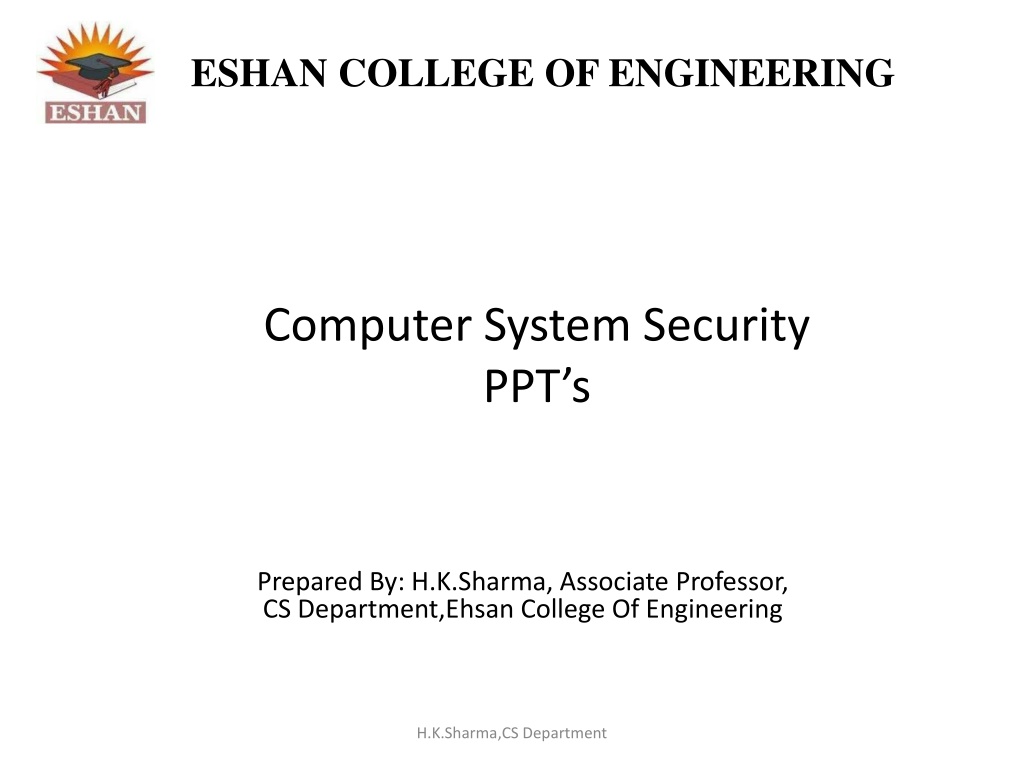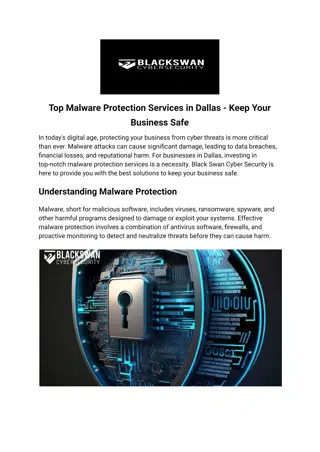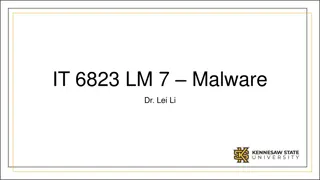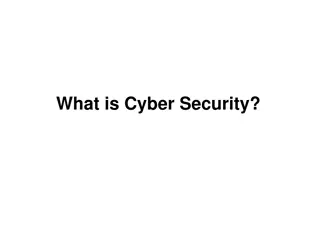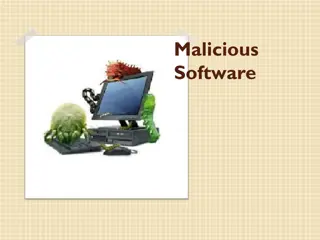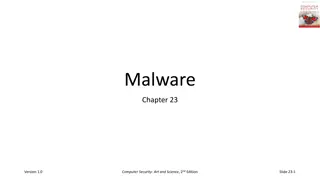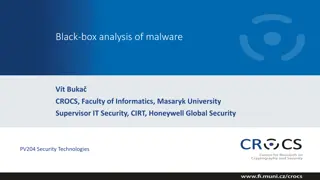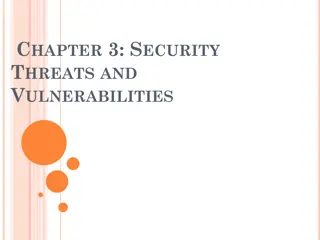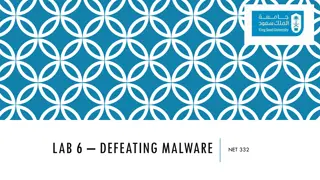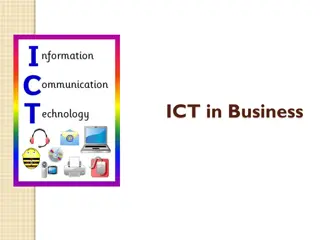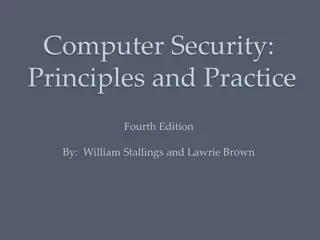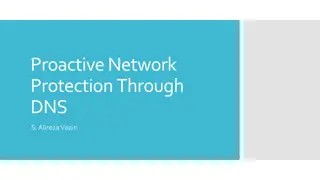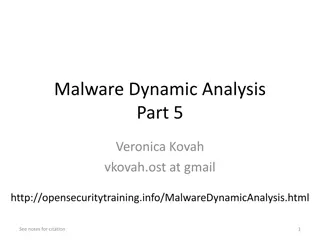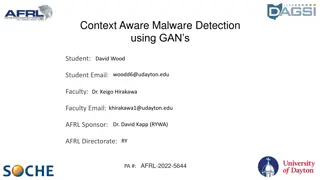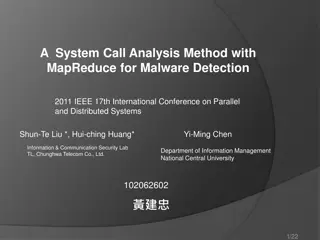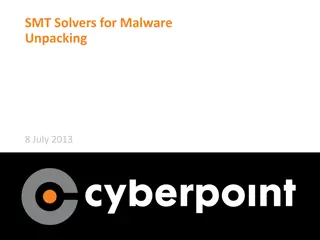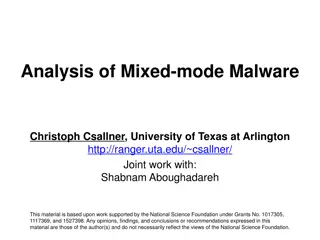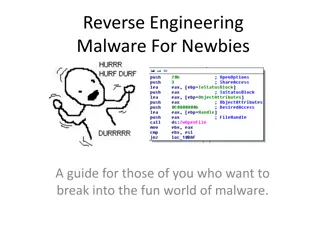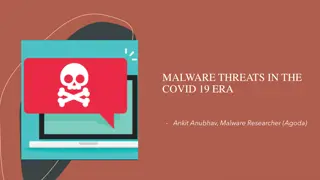Understanding Computer System Security Threats and Malware Types at Eshan College of Engineering
Explore the world of computer system security threats and malware at Eshan College of Engineering through insightful presentations prepared by Associate Professor H.K. Sharma from the CS Department. Learn about security threats like intrusion, phishing, spyware, spam, and malware categories such as viruses, worms, Trojan horses, adware, and more. Dive into the nuances of common malware like backdoors and rootkits, understanding their potential risks and implications on system security.
Uploaded on Oct 05, 2024 | 0 Views
Download Presentation

Please find below an Image/Link to download the presentation.
The content on the website is provided AS IS for your information and personal use only. It may not be sold, licensed, or shared on other websites without obtaining consent from the author. Download presentation by click this link. If you encounter any issues during the download, it is possible that the publisher has removed the file from their server.
E N D
Presentation Transcript
ESHAN COLLEGE OF ENGINEERING Computer System Security PPT s Prepared By: H.K.Sharma, Associate Professor, CS Department,Ehsan College Of Engineering H.K.Sharma,CS Department
ESHAN COLLEGE OF ENGINEERING Security Threats Intrusion: Unauthorized individuals trying to gain access to computer systems in order to steal information Phishing: The practice of using email or fake website to lure the recipient in providing personal information Spyware: Software that sends information from your computer to a third party without your consent Spam: Programs designed to send a message to multiple users, mailing lists or email groups Malware: Programs that infect your machine and carry malicious code to destroy the data or allow intruder to take control of your machine H.K.Sharma,CS Department 2
ESHAN COLLEGE OF ENGINEERING Malware Malware is the shortened form of malicious software. Malware is an umbrella term refers to a variety of hostile or intrusive software including Ransom wares, Computer Viruses, Worms, Trojan Horses, Adware, Scareware etc. H.K.Sharma,CS Department 3
ESHAN COLLEGE OF ENGINEERING Some common malware Virus: A virus is a contagious program or code that attaches itself to another piece of software, and then reproduces itself when that software is run. Most often this is spread by sharing software or files between computers. Worm: A program that replicates itself and destroys data and files on the computer. Worms work to eat the system operating files and data files until the drive is empty. H.K.Sharma,CS Department 4
ESHAN COLLEGE OF ENGINEERING Some common malware Trojan Horse: A Trojan horse or Trojan is a type of malware that looks legitimate but can take control of your computer. Trojan is designed to damage, disrupt, steal, or in general inflict some other harmful action on your data or network. Adware: The least dangerous and most lucrative Malware. Adware displays ads on your computer. H.K.Sharma,CS Department 5
ESHAN COLLEGE OF ENGINEERING Some common malware Backdoors: Backdoors are much the same as Trojans or worms, except that they open a backdoor on a computer, providing a network connection for hackers or other Malware to enter or for viruses or spam to be sent. Rootkit: A rootkit is a malicious software bundle designed to give unauthorized access to a computer or other software. Rootkits are hard to detect and can conceal their presence within an infected system. Hackers use rootkit malware to remotely access your computer, manipulate it, and steal data. H.K.Sharma,CS Department 6
ESHAN COLLEGE OF ENGINEERING Some common malware Rogue security software: This one deceives or misleads users. It pretends to be a good program to remove Malware infections, but all the while it is the Malware. Often it will turn off the real Anti-Virus software. Ransomware: It is a malware where the attacker locks the resources or encrypts the important files. It then demands money, preferably in the form of crypto- currency, to restore the system in its original form. H.K.Sharma,CS Department 7
ESHAN COLLEGE OF ENGINEERING Some common malware Browser Hijacker: A malware program that modifies web browser settings without the user's permission and redirects the user to websites the user had not intended to visit. Its intention is to make money off your web surfing. Using this homepage and not removing the Malware lets the source developers capture your surfing interests. H.K.Sharma,CS Department 8
ESHAN COLLEGE OF ENGINEERING Security Measures Safely mange your password Safely manage your email account Secure your computer Avoid risky behavior online H.K.Sharma,CS Department
ESHAN COLLEGE OF ENGINEERING Safely manage your password Create and maintain a strong password. Consider using a passphrase. Avoid sharing your password with any one. Avoid reusing the same password for multiple accounts. Avoid storing your password where others can see it, or storing it electronically in an unencrypted format (e.g. a clear text file). Use a Password Vault Avoid reusing a password when changing an account password. Do not use automatic logon functionality. H.K.Sharma,CS Department
ESHAN COLLEGE OF ENGINEERING Safely manage your email account Avoid using personal accounts for business workflow Use multifactor authentication Avoid opening attachments from an untrusted source Avoid clicking on links in an email from an untrusted source Avoid providing your user ID and password or other confidential information in an email or in a response to an email Beware of email phishing scams H.K.Sharma,CS Department 11
ESHAN COLLEGE OF ENGINEERING Secure your computer Lock your computer when not attended. Log off or shutdown when going home. Disconnect your computer from the wireless network when using a wired network. Patch and update your operating system . Install and update your anti-virus and anti-malware with the latest security definitions. Enable pop-up blocker on your browser. Back up your systems H.K.Sharma,CS Department 12
ESHAN COLLEGE OF ENGINEERING Avoid risky behavior online Be cautious when handling attachments and links in email, chatrooms or instant messages (IM). Avoid responding to questions via pop-up windows, or click on links in a pop-up window. Be cautious when using Peer to Peer File Sharing applications. Be cautious when browsing the web. One spelling mistake can direct you to undesired websites. Change privacy settings and do not use location features. Limit the personal information you share online. H.K.Sharma,CS Department 13
